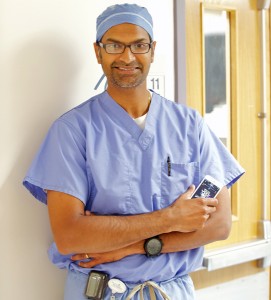Dr. Ananth Murthy explains how the operating room is staffed for the cleft palate operation on Noor. Listen to Dr. Murthy below or read the transcript.
[ca_audio url_mp3=”https://inside.akronchildrens.org/wp-content/uploads/2014/04/staffing.mp3″ url_ogg=”” height=”25″ download=”true” html5=”true” skin=”regular” align=”center”]
Q: Starting with you – who’s all in the room and what are they doing?
Dr. Murthy: Broadly it can be divided into 3 teams: the anesthesia team, the surgical team and the nursing team.
The nursing team is comprised of registered nurses as well surgical techs who assist in the operation. (They assist) with anything from getting the necessary equipment from outside the operating room to handing them to me directly to preparing the patient, helping with the IVs, waking them up and moving them. They take care of everything.
The anesthesia team is comprised mostly of the anesthesiologist and a mid-level provider such as a nurse anesthetist. Sometimes they may have an assistant in there or a student as well. They’re in charge of keeping the patient asleep and keeping them stable through the whole operation depending on what goes on in the operating room.
Q: How many people are on the nursing team?
Dr. Murthy: Typically 2 to 3 and it’s the same with the anesthesia team – 2 to 3.
The surgical team is myself and then I’ll either have my assistant, a resident and possibly a fellow so it could be anywhere from 3 to 4 people as well.
Q: Is this assistant always the same person?
Dr. Murthy: For the video’s purposes it’s probably going to be the same person. I have a PA, her name is Candace. She’ll be in there or it could be the resident.
We have a very good residency program here in Akron where we train future plastic surgeons. They rotate through different hospitals and different services. Usually they spend a couple of months a year with me involved in these operations so they can learn to do it if they want to in the future.
Q: What might the assistant be doing during the operation?
Dr. Murthy: The assistant mostly sucks the blood, cuts sutures and retracts tissue away so I can find what I need. Depending on the level of the resident, they get to actually do some of the closure or dissection of the muscle.
These guys are all very well trained. They’ve already done 5 years of general surgery. They’re in their 6th, 7th, 8th years of training and I would trust them with my own children. I always reassure the families that anybody who’s going to be operating on their child — I would let them operate on my own child. That usually makes them feel better about having that surgical assistant in the room.
Q: What’s the hierarchy in the operating room?
Dr. Murthy: It’s not like a hierarchy. It’s a much different dynamic and it’s not like basketball either. We’re all doing stuff, but the only person doing something to the patient is the surgeon. I’m the guy cutting, but I need everybody else to allow me to do that so the dynamic is different.
It’s not like Formula One racing where you have one driver in the car but you need the engineers, the pit crew, the owners and everybody else to help. It’s not that because there’s more to it.
It’s almost like flying an airplane maybe. That’s probably the closest. You have the tower, the crew, the staff on the planes, the pilot and the engineers. I would say it’s very similar to that.
Actually the surgical world has really embraced that mentality of flying a plane because the airplane industry has some of the best safety standards of any industry. The medical field needs to be there.
We have adopted things they have used before like the checklist where you go over your plan and you confirm it with your staff and the tower and you do the same thing in surgery now.
I think it’s something to look up to as far as safety in a particular industry.









